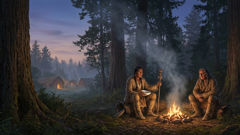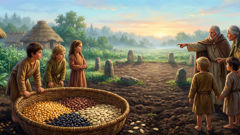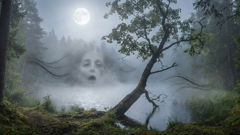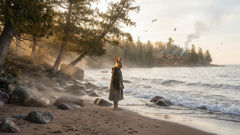Introduction
Beneath a wide sky that presses its blue down to the rim of the mesa, the world felt like a held breath. The air shimmered with heat and possibility; juniper and sage sent their dry scent across the stone, and far below, the valley kept its hidden silver threads of river. In the village on the lip of the mesa, the houses seemed to grow from the earth like slow, patient thoughts. That year the rains had been late, and the elders gathered more often beneath the shade of corncribs and lintel beams, speaking in soft, serious tones. Among them was little Honi, who watched the adults with the same wide attention she reserved for the flights of hawks and the first wildflowers cropping up after a cold night. She had seen the Kachina dancers only in glimpses before: faces painted with the colors of dawn and storm, cloaks that spoke of clouds, rattles whose voices threaded the dancers to the beat of the world. Her grandmother's hands, callused and sure, had stroked the smooth wood of a small carved doll and said, "These are teachers. These are good guests." But words tumbled into mystery as often as they became clear, and Honi's curiosity felt like a living thing she could not set aside. She wanted to know what made the Kachinas move between the sky and the people, how they kept the clouds from forgetting to weep, how a carved figure could hold a voice. Her journey through the seasons—through lessons given quietly at dawn, through dances under starlit roofs, and through the telling and guarding of tradition—would teach her the patient grammar of respect and the truth that some knowledge is tended, like corn, with both prayer and restraint. Respectfully, this story walks in the shadow of Hopi life and the Kachinas' roles as messengers and teachers, honoring that many details of ceremonial life remain private among Hopi peoples.
Faces Between Worlds: Origins and Lessons
The elders told stories to Honi in a voice that was neither hurried nor slow—a tone tuned to the rhythm of planting. "Kachinas are not simply creatures of wood and paint," her grandmother would say, shaping the words like bowls. "They are the faces of the powers that move the clouds, the teachers who remind us of the laws of living well." Honi listened while the afternoon folded into evening and the lanterns threw their soft, honeyed light across woven blankets. She learned that the Kachinas were many: some bore the straightforward shapes of animals, others the layered geometry of seasons, and a few wore masks that made a person's breath hitch because their eyes were so full of sky. These were the ones closest to the winds and the storms.
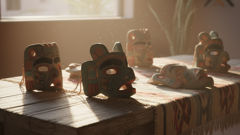
When she asked how a Kachina could be both dancer and spirit, her grandmother smiled without revealing secrets meant for sacred fires. "They walk here in skin like ours and also in ways we cannot house," she said. "We give them offerings and call them forward, and they answer with teaching. The dolls—kachinas carved from cottonwood and given to children—are reminders of the lessons. They say: remember respect; remember to plant when the time comes; remember to share." Honi traced the lines of a small doll, feeling the worn hand of the woodcarver in every rounded curve. She noticed how the paint had been layered and how certain colors always recurred: the deep blue of rain, the reddish-brown of earth, the bright ochres of corn. Each hue was a word in a language larger than human speech.
As the seasons blurred—seedtime, waiting, the flush of first leaves—Honi sat with weathered women who spoke of cycles as living grammar. The Kachinas, they explained, showed up at the thresholds of the year: in parades of masks when first light arrives, in quiet visits to sleeping homes, in drumming that seemed to tap the pulse of the corn. The Kachinas carried thunder in their belts and patience in their footfalls; they were teachers of balance. A story circulated about a cloud Kachina who was slow to hurry the rains because the people had forgotten to make offerings of thanks after a generous season. The Kachina paused to teach them gratitude; it took many small things—mended baskets, shared water, a promise kept—to coax that spirit to open its hand and let the sky spill.
The boundary between storyteller and listener blurred for Honi. She wanted to witness how the Kachinas arrived in their fullness, yet she also felt the tug to keep certain things close. Her grandmother taught her that some knowledge must be held by those who are entrusted with it: it is a way to honor the beings and the ancestors who walk those other thresholds. "Never treat these things like entertainments to be scattered," her grandmother warned. "Some things are medicine. They ask for care, not for being shown like trinkets." That counsel shaped Honi's attention like the careful stroke of a potter's hand. She learned to observe without the sharp hunger for spectacle that can make spiritual life into a marketable image. Instead, she learned to listen: to the low rattle of a dancer's foot, to the cough of wind through a cornstalk, to the silence after a story when the lesson had settled into place.
There were tales of particular Kachinas that Honi cherished. One was of a Kachina who wore a mask of ceded turquoise and who taught children how to listen to the water under the stones. Another told of a trickster-faced figure who reminded people that humility matters even when abundance is present. Yet the most persistent idea across these tales was that the Kachinas do not serve the people without reciprocity; the people must care for the land and each other, and in return the Kachinas keep the balance. You could think of them as ambassadors, Honi was told—ambassadors from the vastness to the village—and ambassadors require trust. The carved dolls, then, were not mere souvenirs; they were tokens of a living relationship: small, patient reminders to honor the agreements a community maintains with weather, seed, and sky.
As Honi grew, the concept of reciprocity became a living rule. If a child took a doll and treated it with care, practiced offering thanks, and learned the songs in softened mornings, then the voice of the lesson would settle into their bones. If, however, one showed disrespect—if seeds were wasted, if sharing was forgotten—those lessons would seem distant. The Kachinas, the elders said, would not be cruel; they would be exact. They would teach through withheld rain or through crops that asked for mending. These consequences were not punishment in the narrow human sense, but the honest math of life: cause and effect, tending and result. Honi learned this as she watched the village balance between scarcity and generosity, understanding that the Kachinas' teachings were not only for ceremony but for the daily practice of living in community.
There is also humor in the old stories, and elders laughed as much as they warned. They spoke of Kachinas who preferred to hide the last ear of corn for the family that most needed it, or who nudged a stubborn rain cloud just a little westward so that one mesa would be spared a late frost. The spirit world, in this telling, had personality; it was not a strict ledger but a family with moods and favorites and a sometimes exasperating sense of timing. Honi loved these parts best: the idea that the great and the small were braided together. A Kachina could be thunder and mischief in the same footfall, dispensing both weather and a reminder to laugh at one's own pride.
Most of all, the elders taught Honi how to hold questions. Not every story must be solved with a definitive answer, they said. Some mysteries are the threads by which wisdom is woven. Honi learned to sit in that space—curious, patient, respectful—because to rush to own the story is to unravel its power. The Kachinas walked both streets and skies, visible in paint and dance and invisible in the memory of rain; they were not possessions but presences. For Honi, the work of learning was less about collecting facts and more about learning the ethics of keeping what is entrusted to you: the same ethics that make a field yield corn, or a community hold together through drought and feast. She began to see herself as a keeper-in-training, someone who might one day balance the responsibilities of saying thanks and holding silence.
Dances, Dolls, and the Quiet Work of Remembering
When the parade of dancers came, Honi felt the ground answer. The rhythm of feet and stomp was not merely sound but a kind of language: it spoke of corn planted at the right depth, of saved seed, of hands that had learned to mend. The dancers arrived in the dawn like a promise materialized—masks catching the first light, cloaks fluttering like clouds newly formed. Children were given places of honor at the edge of the plaza; adults stood in respectful lines, and the drums called the cadence of the day. Honi watched each movement as if she could store it: the tilt of a masked head that said, in its small way, Be steady; the step that summoned rain like a conversation in the clay of the world. The dancers disappeared into the crowd at the end of the performance, but Honi had learned that the performance was only a single voice in a larger chorus.

The carved dolls that people gave to children after the dances were a separate kind of grace. Honi noticed how each doll was individualized: some were squat and broad with faces that seemed to hold sunlight; others were slender and painted with the narrow line work of lightning. Old men and women who had made these dolls—carving from cottonwood with tools that had been handed down—knew how to balance shape and spirit without overstepping the line into spectacle. The making of a doll, the elders insisted, was not an act of imitation but an act of remembering. The carver listened to the grain of the wood, feeling where a limb wanted to be born, and in that listen, the doll found its voice. Honi touched the back of a carved arm and felt, as if by osmosis, the slow patience of the maker.
One winter, when the moon drew long shadows across the courtyard, an old carver named Tewa took Honi aside. He did not tell her the private names of certain Kachinas; instead he taught her how to see a doll's gesture. "Look for the lesson it wishes to hold," he said, tapping a tiny painted foot. "Is it humility? Is it protection? Is it the promise of rain? The doll carries what the community needs a child to remember." Honi learned to ask not, What is the secret? but rather, What does this remind me to be? In this shift of question, sacredness remained honored; care became the central practice.
Not all lessons were solemn. At the feast after the winter ceremonies, children chased one another through columns of smoked corn hung to dry; elders exchanged jokes about rain clouds that took the longest routes to their mesas. The Kachinas, said one storyteller, have a sense of humor like the wind: it will ruffle you, sometimes lift you, sometimes rearrange your hair, and then move on without comment. These stories softened Honi's understanding. The spirit world was not a distant tribunal but a living relationship in which laughter and missteps had their place. When a dancer’s heel stumbled and the village laughed kindly, the Kachina in that dancer adjusted, and the rhythm carried on. The idea that spiritual beings accommodated human foibles made Honi's reverence tender rather than fearful.
As Honi matured, she also saw how the village placed limits around certain knowledge. She witnessed quiet meetings where elders decided who would learn certain songs, who would oversee corn planting, who would carry the responsibility of mending communal tools. The Kachinas' presence was woven into these decisions, but not in a way that let outsiders consume the life of the community. There were boundaries. Honi learned to respect them. She began to understand the line between cultural curiosity and cultural stewardship: curiosity can open a door; stewardship is taking responsibility for what you find on the other side. For Honi, stewardship meant learning the songs and their rhythms, practicing offerings with the humility of a beginner, and understanding that the hospitality extended to the Kachinas had an ethic: one does not show every guest to every room, and one certainly does not turn sacred rooms into stages.
One spring, a drought held the valley. People offered what they could: prayers, careful rationing, mended tools, and a collective increase in generosity toward the elderly and those most in need. The Kachinas were invoked in song and dance, and small signs of change came at the edges: a nervy shoot of green, a slight thickening of evening clouds, a single thunder that did not dissipate but deepened and rolled for miles. Honi watched the work of the community stitch itself back together—neighbors sharing water, children carrying extra bundles of wood, storytellers staying up late to teach the younger ones the old songs that contained the grammar of patience. She saw how the Kachinas’ role was not to fix everything by themselves but to show the pathways by which people could act rightly. The spirits amplified the kindness already present and taught the community to become the kind of people for whom rain would come.
Over time Honi became one of those who could sit by a younger child and teach them how to carry a doll with restraint and meaning. She taught them how to hold the carved piece in both hands and whisper a promise to take care of the corn and to be gentle with the words they used about the sacred. She passed on the lesson that a gift—whether carved from cottonwood or given in counsel—demands reciprocity. This passing of responsibility felt like the work of a river finally reaching the plain: steady, unflashy, necessary. The Kachinas remained, in the community's memory, as both weather and teacher, as mischief and guardian. They asked nothing glamorous: only that people remember the law of shared labor and shared blessing.
Honi never ceased to be surprised by the inward smallness and outward breadth of what she had learned. It was not merely that the Kachinas brought practical favors like rain; it was that they consistently redirected attention to relationship—to the land, to one another, to the responsibility that comes with living in a place. She learned to measure her deeds not by the applause of the plaza but by how a neighbor fared, by how a field responded. The Kachinas taught her the economy of giving and receiving that keeps a people in balance with the seasons and with one another. That economy, she discovered, was the deeper magic behind every dance and every carved doll.
Conclusion
Years layered themselves softly over Honi. Where she had once stood at the edge of the plaza with curious eyes, she eventually stood with hands that could carve and voices that could teach. Her grandmother's hands had taught her the patience of shaping and the ethic of guarding; elders had taught her to ask questions that honored boundaries. In the quiet of a late summer dusk, Honi understood what the elders meant when they said the Kachinas are teachers rather than trophies. They were not trophies to be owned or spectacles to be performed for outside eyes; they were relationships to be tended. The village, in its small, persistent ways, was the place where those relationships were practiced: where children learned how to carry a doll with intention, where a community decided who would take responsibility for certain songs and seed, where laughter lightened the load and ritual steadied it. Honi took part in the work of remembering: naming what care required, offering what was appropriate at the right time, and holding back the stories that were not hers to tell. In doing so she learned the larger lesson the Kachinas had been trying to teach her all along—that wisdom requires both speech and silence, that the line between the human and the sacred is not a border to be crossed freely but a threshold to be honored. And so the dances continued, the dolls continued to be carved and given, and the rain came and went by its own old laws; through each season, the people and the Kachinas kept their careful, living conversation, each tending the other with the reciprocal work of care.







